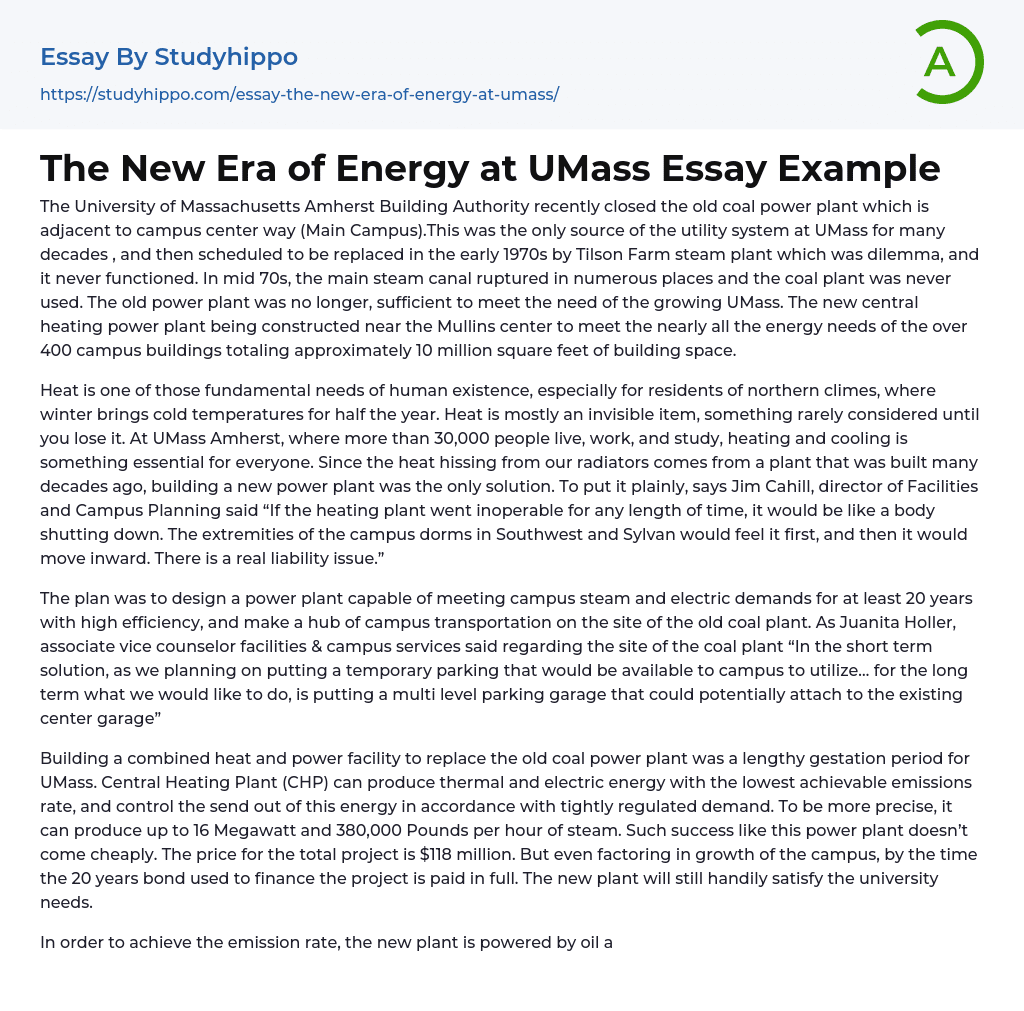The University of Massachusetts Amherst Building Authority recently closed the old coal power plant located next to campus center way (Main Campus). The closure was necessary as this power plant, which had been UMass's sole energy source for many years, became obsolete after it was supposed to be replaced in the early 1970s by the Tilson Farm steam plant. However, due to multiple ruptures in the main steam canal during the mid-70s, this replacement never became operational and left the coal plant useless. With UMass's expansion over time, it became evident that relying on the old power plant would no longer suffice to meet its growing energy needs. Consequently, a new central heating power plant is currently under construction near the Mullins center. Once completed, this new facility will cater to almost all of UMass's en
...ergy requirements for more than 400 campus buildings spanning approximately 10 million square feet of space.
Heat is essential for humans, especially in colder regions with long winters. It is often taken for granted until it is lost. At UMass Amherst, where there are over 30,000 residents, employees, and students, heating and cooling are crucial for everyone. The heat is provided by radiators connected to an old power plant. To solve this problem, the only solution was to build a new power plant. In simpler terms, Jim Cahill, director of Facilities and Campus Planning at UMass Amherst explained that if the heating plant were to malfunction for an extended period of time, it would have serious consequences. The dormitories on the outskirts of campus in Southwest and Sylvan would be the first to feel these effects whic
would eventually impact the entire campus. This presents a significant liability concern.
The goal was to establish a power plant that could efficiently supply steam and electricity for the campus's needs for at least two decades, while also serving as a transportation hub at the former coal plant site. Juanita Holler, associate vice counselor facilities & campus services, mentioned their plan to create a temporary parking lot soon for campus use. However, their ultimate plan involved building a multi-level parking garage that would connect with the current center garage.
The construction of a combined heat and power (CHP) facility at UMass took a significant amount of time to complete, serving as a replacement for the previous coal power plant. This new facility has the capability to produce both thermal and electric energy, while keeping emissions at an extremely low level. Additionally, it is equipped with technology that allows for efficient distribution of this energy based on demand regulations. The CHP facility has a maximum capacity of generating 16 Megawatts and producing 380,000 Pounds per hour of steam. The total expenses for this project amounted to $118 million; however, despite its high cost, considering the growth of the campus, it is anticipated that the new plant will sufficiently meet university needs over the span of a 20-year bond utilized for financing.
According to John Mathews, the assistant director of campus projects for Facilities and Campus Planning, the new power plant successfully meets emission standards. It uses oil and natural gas as its energy sources and is a combined heat and power (CHP) facility. This CHP facility produces almost double the amount of steam
and five times more electric power compared to the previous power plant. Additionally, it has reduced greenhouse-gas emissions by about 85% on a tons-per-year basis. UMass considers the construction of this CHP facility a significant achievement for both the university and the community because it replaces an old coal plant. As part of this initiative, a regeneration system has been implemented to reuse approximately 200,000 gallons per day of effluent from the Amherst municipal wastewater treatment system for boiler and cooling-tower purposes.
- Energy Development essays
- The elements essays
- Voltage essays
- Solar Energy essays
- Nuclear Energy essays
- Alternative Energy essays
- Oxygen essays
- Atmosphere essays
- Coral Reef essays
- Desert essays
- Earth essays
- Ocean essays
- Lake essays
- Sea essays
- Biodiversity essays
- Natural Environment essays
- Forest essays
- Soil essays
- Water essays
- Rainbow essays
- Ecosystem essays
- Volcano essays
- Wind essays
- Forestry essays
- Bottled Water essays
- Atom essays
- Big Bang Theory essays
- Density essays
- Electricity essays
- Energy essays
- Force essays
- Heat essays
- Light essays
- Motion essays
- Nuclear Power essays
- Physiology essays
- Sound essays
- Speed essays
- Temperature essays
- Thermodynamics essays
- Air Pollution essays
- Carbon Dioxide essays
- Climate essays
- Deforestation essays
- Ecology essays
- Endangered Species essays
- Environmental Issues essays
- Environmental Protection essays
- flood essays
- Greenhouse Gas essays




